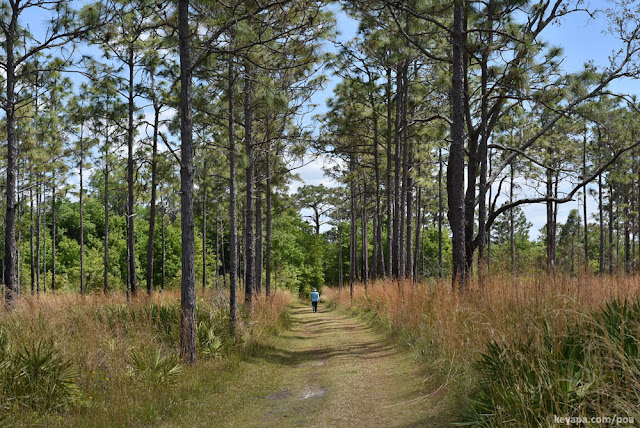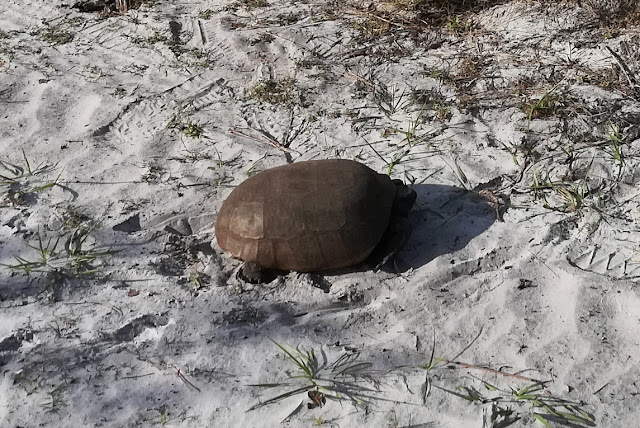 |
| Andropogon virginicus and Aristida beyrichiana in longleaf pine sandhill near Lake Apopka, Florida |
Diversity in either species or function has been usually touted as a way for natural communities to resist encroachment by invasive species. This so-called Elton Hypothesis postulates that invasion is favored in areas with lower resident diversity, and that the greater the diversity, the less probability there is for an invasive to gain traction in the community.
There are several mechanisms by which such communities can have this feature. First, a diverse assemblage of species or functional types can use the surrounding resources more completely, and thus prevent invasives from easily being able to exploit an empty niche. Second, a diverse community has a greater degree of interspecific competition, which again means that it will be more difficult for invasive species to gain a foothold.
 |
| Imperata cylindrica smothering a roadside in Kissimmee, Florida |
Imperata cylindrica (cogongrass) is a tropical and subtropical species that is one of the worst invasive plants in the world, blanketing up to 500 million hectares worldwide and costing governments millions in preventative and eradication efforts.
The species is of particular concern for pine ecosystems (both natural and artificial) in the southeastern USA. In one case, it threatens a forest community called the Florida longleaf pine sandhill, which is anchored by a pine called Pinus palustris, with an understory of oak species and a ground layer of perennial grasses and other herbaceous plants. The major grasses include Aristida beyrichiana (wiregrass) and Andropogon virginicus (broomsedge grass).
 |
| The distinctive fluffy seedhead of I. cylindrica in amongst the foliage in Kissimmee, Florida |
Cogongrass invasion of this community not only alters the lower herbaceous and shrub layer, but it slowly destroys the entire pine community by killing pine seedlings and smaller trees due to soil resource competition and an altered fire regime (which is not only more frequent but also significantly larger and hotter than normal). For example, the biomass of pine seedlings after 3 growing seasons in competition with cogongrass was only an astounding 2.4% that of pine seedlings with no competition, and 18% of pine seedlings in competition with only native vegetation (Daneshgar et al, 2008).
 |
| Distinctive fluffy seedheads of Imperata cylindrica in gated community in Kissimmee, FL |
In order to determine whether plant diversity hinders the invasion patterns of cogongrass, some researchers did a series of experiments in Northern Florida. They selected 5 understory native grasses, forbs, and shrubs, then created mixtures and monocultures of each of the test species. Cogongrass was introduced into these 40 mesocosms, and the amount of biomass and cover of the invasive grass was then monitored (Daneshgar and Jose, 2009).
Contrary to expectations, the most diverse environments did not resist the cogongrass best. Instead, monocultures of the grass A. virginicus (broomsedge) were the most resistant to invasion. In addition, mixtures that contained broomsedge resisted cogongrass better than mixtures that did not contain this species.
The authors attributed the ability of broomsedge to compete effectively against cogongrass to its formidable underground root system, which was able to persist even in the midst of the dense roots and rhizomes of the invader, and they suggested that this native species be used to deter cogongrass from overwhelming Florida pine sandhill ecosystems.
Literature Cited
Daneshgar P and Shibu Jose (2009). Broomsedge Communities Are Resistant to Invasion by Cogongrass (Florida). Ecological Rest. December 2009 27:383-385
Pedram Daneshgar, Shibu Jose, Alexandra Collins, Craig Ramsey, Cogongrass (Imperata cylindrica), an Alien Invasive Grass, Reduces Survival and Productivity of an Establishing Pine Forest, Forest Science, Volume 54, Issue 6, October 2008, Pages 579–587, https://doi.org/10.1093/forestscience/54.6.579












































